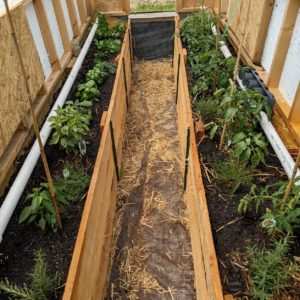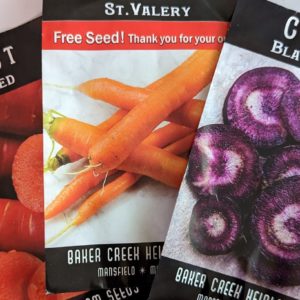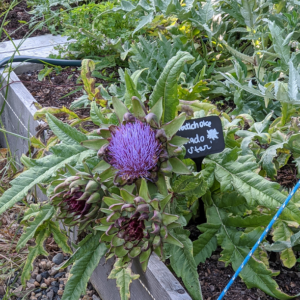In part 1, we went over a list of seeds from different families that you could plant. So how do you use these plants in your garden plans? First off, let’s talk about the benefits of combining species that complement each other in the garden. They can:
- Attract beneficials
- Aid pollination
- Repel pests
- Provide shade
- Provide support
- Save space
- Improve soil health
- Suppress weeds
- Conserve soil
- Conserve water
Generally, the aromatic plants will tend to repel pests, these include many of the herbs in a garden such as the mints, and the umbels, but also many of the composites as well. Much of the repellent or insecticidal and nematicidal activity of these groups may be associated with naturally occurring metabolites including, terpenes. The alliums are aromatic herbs high in sulfur compounds that work to repel pests.
In flower, the aromatic herbs attract beneficial insects: pollinators, predatory wasps and parasitoids. This is the basis of planting some of these with plants that are susceptible to pests. For example, tomato and potato plants are attractive to hornworms, which will strip the foliage in short order. Bruconid wasps are ectoparasites of hornworms and a good way to attract the beneficial wasp is to plant flowering plants that produce lots of nectar including sweet alyssum and umbels, such as fennel and dill. For the very same reason, it is a good idea not to plant tomatoes and potatoes near each other.
Cool Season/Warm Season Plants
Organize your seed lots based on how and when you plan to plant. Some suggestions on organizing your seed lots:
- Early indoor starts (EIS)
- Early spring (cool season) direct sowing (ESD)
- Direct late spring (warm season) sowing (LSD)
- Fall direct sow (cool season) (FDS)
- Plants that require trellising, direct sow (pole beans, cucumbers, squash) (LST)
Cool season plants include:
- Alliums
- Arugula
- Broccoli
- Brussels sprouts
- Cabbage
- Cauliflower
- Carrots
- Kale
- Lettuce
- Peas
- Parsley
- Radish
- Spinach
Sow seeds 2 to 3 weeks before the last spring frost date (EDS), and again in mid- to late-summer (FDS), about 10 weeks before the first fall frost date in your area. Direct sow these plants.

Warm season plants include:
- Basil
- Beans
- Cucumbers
- Eggplant
- Melons
- Peppers
- Potatoes
- Tomatoes
- Squash
- Sunflowers
Sow seeds of warm season plants after the last spring frost date when the soil has warmed up to 50F. Potatoes are started as “seed potatoes”, and may be directly sown when the soil has warmed. For tomatoes, peppers and eggplant, sow indoors in late winter to get a jump on the growing season (EIS).
Interplanting Cool Season and Warm Season Crops
Interplanting warm season crops with cool season crops has a number of advantages including
- Saving space
- Creating shade for crops that can’t take the heat
- Making plants harder for pests to find
- For example, plant pepper plants among spinach, lettuce and alliums
- Plant bush beans and cucumbers among the brassicas (broccoli, cauliflower, etc.)
Here are some other combinations that will help to increase gardening success:
- Interplant carrots with alliums, such as onions and leeks to repel carrot flies

- Sow carrots and radishes together
- The radishes grow faster; and when you harvest, you’ll also make room for the carrots to develop
- Sow large leaf brassicas among alliums will help to suppress weeds
- Sowing aromatic herbs with brassicas may help to repel pests and attract beneficials
- Interplant tomatoes, peppers and eggplant with aromatic herbs including parsley, sage, rosemary, basil, alliums (chives, garlic, leeks, onions) marigolds and calendula
- Plant potatoes near beans, basil, marigolds, calendula or sweet alyssum
- Sow cucumbers and sunflowers together; sunflowers will give the cucumbers a structure to grow up on, and may repel cucumber beetles.
- The classic garden planting is corn, beans and squash, the large squash leaves shade the soil to conserve soil moisture and to suppress weeds, and the corn stalk provides support to the runner beans. The beans in turn, return nitrogen to the soil.
- Consider growing mushrooms, especially if you mulch your garden with an organic mulch. The best mushrooms to start with are wine caps and oyster mushrooms. They will benefit from the organic matter and the shade of the overstory veg crop. These mushrooms are saprophytes, which break down organic matter and are compatible to the vegetable garden. Purchase the sawdust spawn for this application. Some online sources include:
Stagger sowing crops
- Sow seeds of crops every two weeks to stagger the harvest.
- This has several advantages including
- Avoiding periods of inclement weather, which could threaten a crop
- Provides a steady harvest over time
- And an added advantage is avoiding pest cycles.
- An earlier or later planting may avoid cabbage butterfly, for example.
- Sow carrots and radishes as a fall crop to avoid carrot flies
Join us next week for the conclusion of the Seeds of Change series.
– Signing off for now, Joe






